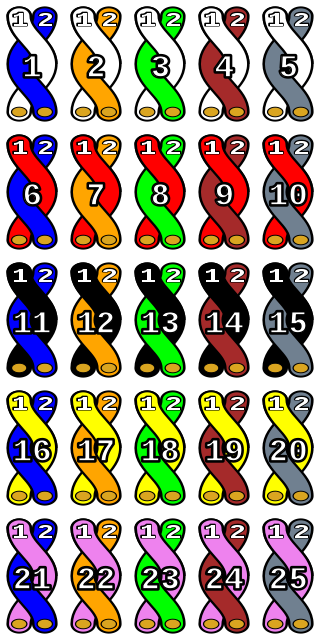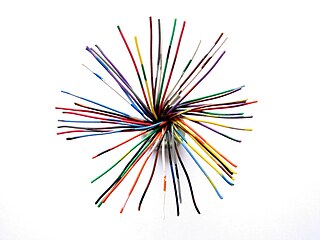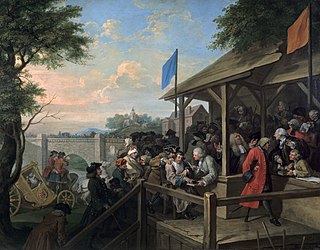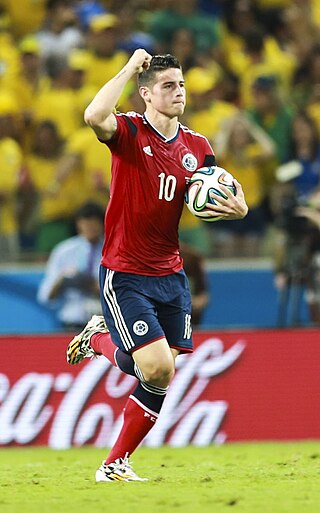
A color code is a system for encoding and representing non-color information with colors to facilitate communication. This information tends to be categorical though may also be sequential.

Twisted pair cabling is a type of communications cable in which two conductors of a single circuit are twisted together for the purposes of improving electromagnetic compatibility. Compared to a single conductor or an untwisted balanced pair, a twisted pair reduces electromagnetic radiation from the pair and crosstalk between neighbouring pairs and improves rejection of external electromagnetic interference. It was invented by Alexander Graham Bell.
In heraldry, purpure is a tincture, equivalent to the colour purple, and is one of the five main or most usually used colours. It may be portrayed in engravings by a series of parallel lines at a 45-degree angle running from upper right to lower left from the point of view of an observer, or else indicated by the abbreviation purp.

The cockatiel, also known as the weero/weiro or quarrion, is a medium-sized parrot that is a member of its own branch of the cockatoo family endemic to Australia. They are prized as household pets and companion parrots throughout the world and are relatively easy to breed compared to other parrots. As a caged bird, cockatiels are second in popularity only to the budgerigar.

Tincture is the limited palette of colours and patterns used in heraldry. The need to define, depict, and correctly blazon the various tinctures is one of the most important aspects of heraldic art and design.

The 25-pair color code, originally known as even-count color code, is a color code used to identify individual conductors in twisted-pair wiring for telecommunications.

Political colours are colours used to represent a political ideology, movement or party, either officially or unofficially. They represent the intersection of colour symbolism and political symbolism. Politicians making public appearances will often identify themselves by wearing rosettes, flowers, ties or ribbons in the colour of their political party. Parties in different countries with similar ideologies sometimes use similar colours. As an example the colour red symbolises left-wing ideologies in many countries, while the colour blue is often used for conservatism, the colour yellow is most commonly associated with liberalism and right-libertarianism, and Green politics is named after the ideology's political colour. The political associations of a given colour vary from country to country, and there are exceptions to the general trends, for example red has historically been associated with Christianity, but over time gained association with leftist politics, while the United States differs from other countries in that conservatism is associated with red and liberalism with blue. Mass media has driven a standardization of colour by political party, to simplify messaging, while historically the colour a candidate chose to identify with could have been chosen based on other factors such as family or regional variations.

Colour sergeant is a rank of non-commissioned officer found in several armies and marine corps.

Electrical wiring is an electrical installation of cabling and associated devices such as switches, distribution boards, sockets, and light fittings in a structure.
Electrical wiring in the United Kingdom is commonly understood to be an electrical installation for operation by end users within domestic, commercial, industrial, and other buildings, and also in special installations and locations, such as marinas or caravan parks. It does not normally cover the transmission or distribution of electricity to them.
The international standard IEC 60446Basic and safety principles for man-machine interface, marking and identification - Identification of equipment terminals, conductor terminations and conductors was a standard published by the International Electrotechnical Commission (IEC) that defined basic safety principles for identifying electrical conductors by colours or numerals, for example in electricity distribution wiring. The standard has been withdrawn; the fourth edition was merged in 2010 into the fifth edition of IEC 60445 along with the fourth edition, IEC 60445:2006.
A thermoplastic-sheathed cable (TPS) consists of a toughened outer sheath of polyvinyl chloride (PVC) thermoplastic, covering one or more individual annealed copper conductors, themselves insulated with PVC. This type of wiring is commonly used for residential and light commercial construction in many countries. The flat version of the cable, with two insulated conductors and an uninsulated earth conductor, is referred to as twin and earth. In mainland Europe, a round equivalent is more common.

The English-originating version of eight-ball pool, also known as English pool, English eight-ball, blackball, or simply reds and yellows, is a pool game played with sixteen balls on a small pool table with six pockets. It originated in the United Kingdom and is played in the Commonwealth countries such as Australia and South Africa. In the UK and Ireland it is usually called simply "pool".
The British Colour Council (BCC) was an industry standards organisation, active from the 1930s to the 1950s, which produced indexes of named colours for use by government, industry, academia, and horticulture.
Colours of the Syrian hamster can be described in three ways: as "self", "agouti" or "combinations". Self colours are a consistent coat colour with the same colour topcoat and undercoat. Agouti hamsters have a ticked coat, where each individual fur is banded in different colours. Agouti hamsters also have "agouti markings" which consist of dark cheek markings, a dark marking on the head, and a light underbelly. Combinations are produced when two self or agouti colours are present.
Time multiplexed optical shutter (TMOS) is a flat panel display technology developed, patented and commercialized by Uni-Pixel Displays, Inc. TMOS is based on the principles of total internal reflection (TIR), frustration of TIR (FTIR) and field sequential colour generation (FSC). This combination of features make it suitable for applications such as mobile phones, televisions and signalling systems.

Away colours or road colours are a choice of coloured clothing used in team sports. They are required to be worn by one team during a game between teams that would otherwise wear the same colours as each other, or similar colours. This change prevents confusion for officials, players, and spectators. In most sports, it is the visiting or road team that must change.
Corps colours, or Troop-function colours were traditional worn in the German Wehrmacht from 1935 until 1945 as way to distinguish between several branches, special services, corps, rank groups and appointments of the ministerial area, general staff, Oberkommando der Wehrmacht, up to the military branches Heer, Luftwaffe and Kriegsmarine. The corps colour was part of the piping, uniform gorget, shoulder strap, as well as part of the arabesque and lampasse of any general officer and flag officers. It was also part of heraldic flags, colours, standards and guidons.








